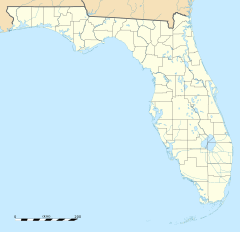Temple Crest facts for kids
Quick facts for kids
Temple Crest
|
|
|---|---|
| Country | United States |
| State | Florida |
| County | Hillsborough |
| City | Tampa |
| Time zone | UTC-5 (Eastern (EST)) |
| • Summer (DST) | UTC-4 (EDT) |
Temple Crest is a neighborhood and district located northeast of Tampa, Florida. In 2000, about 8,621 people lived there.
Contents
Discover Temple Crest: A Tampa Neighborhood
Temple Crest is a neighborhood in Tampa, Florida. Its borders are 30th Street to the west and Temple Terrace to the east. To the north is Busch Blvd., and to the south is the Hillsborough River.
Fun Places Near Temple Crest
Many exciting places are close to Temple Crest. Busch Gardens, a popular theme park, is just north of the neighborhood. The University of South Florida campus is also less than two miles (3 km) away.
Temple Crest History: From Ranch to Neighborhood
Temple Crest was once part of a huge 19,000-acre (77 km2) property. This land was called the Riverhills Ranch. Bertha Potter Palmer from Chicago bought it in 1914. After she passed away, her sons sold the land to different builders.
Growing Oranges and New Towns
One builder, D.C. Gillette, created the world's largest orange grove. It had 5,000 acres (20 km2) of Temple Orange trees. The Palmer estate then formed two companies. These were Temple Terraces, Inc. (which included Temple Crest) and Temple Terrace Estates, Inc. (which is now Temple Terrace).
When it was first built, Temple Crest was seen as a fancy place to live. It was just as grand as Temple Terrace. On September 12, 1924, more land from Temple Terraces Inc. was sold. It was bought by Florida Realty and Mortgage Company. The area was then renamed Temple Crest. It stayed part of Hillsborough County until 1961. That year, it officially became part of Tampa.
The Hillsborough River: Nature and History
The Hillsborough River forms the southern edge of Temple Crest. This river has a long and interesting history.
Early River Power and Challenges
In 1897, an electric dam was built on the river. It cost $150,000. This dam was located near where 40th Street and 56th Street are today. This is now part of the Temple Crest neighborhood.
In 1898, the dam was blown up by cattle ranchers. They were upset about losing grazing land. They tried three times to destroy it. The first attempt was in 1897, soon after it was finished. When the water is low, you can still see parts of the old dam.
Later, in 1898-1899, TECO bought the electric company. They built a new dam further downstream. In 1899, Tampa's first water plant was built. It used well water to supply the city. People voted to buy this plant for the city in 1923.
River Changes Over Time
In the early 1900s, the Hillsborough River area was heavily logged. Trees like cypress, pine, and oak were cut down. In 1916, Bertha Potter Palmer bought 19,000 acres (77 km2) of land along the river. She called it Riverhills Ranch. She used it as a hunting preserve.
In 1923, the city of Tampa built a water treatment plant. It used water from above the dam for drinking. A big flood in 1933 washed away the TECO dam. TECO did not rebuild it. In 1944, Tampa finished building the current dam. This dam is used to hold drinking water for the city. The old waterworks company was then closed.
The River Today: A Living Ecosystem
The Hillsborough River is home to many animals. Some are endangered species. There are also large bird nesting areas. Local students in Hillsborough County visit the river in sixth grade. They go to a place called 'Natures Classroom'. There, they learn about the river's ecosystem and local animals. The Hillsborough River dam helps supply drinking water for Tampa.
The river above the dam is sometimes called a "reservoir." However, it is still part of the Hillsborough River. This river starts in the Green Swamp and flows to Tampa Bay.
Protecting the River's Future
The middle part of the Hillsborough River is a rich ecosystem. Orange Lake, in Temple Crest, is a bird sanctuary. It is also a living wetland. Further upstream, you can see cypress trees in the water. This looks like old Florida.
However, the middle river faces challenges. Water management groups sometimes take water from the river. This can lower water levels. When water levels are low, wildlife can disappear. Dead zones can also appear along the riverbanks. Many people are working to protect the river. They want to make sure it has enough water to stay healthy. This will help protect its plants and animals.
The Hillsborough River was featured in a book. It was called "River of the Golden Ibis" by Gloria Jahoda in 1973.
Education in Temple Crest
Students in Temple Crest attend schools managed by Hillsborough County Public Schools.



